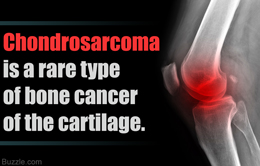

Chondrosarcoma is a rare type of bone cancer, that develops in the cartilage cells, and belongs to the category of cancers called sarcomas. It is the second most common type of bone cancer, first being osteosarcoma; and accounts to 26% of primary bone cancer. To know about the symptoms, causes, and treatment of this disease, read on...
 Chondrosarcoma is a malignant tumor of bone that grows in the cartilage cells, and affects the legs, shoulder blade (scapula), upper arms, rib cage or pelvis bones. Cartilage plays an important role in the growth process as it is a specialized, connective tissue that is present in adults, from which most bones develop. This tumor is slow-growing and usually grows within a bone or on its surface.Chondrosarcoma can be categorized into primary and secondary tumors. Primary chondrosarcoma develops from a small collection of cartilage cells; whereas secondary type, develops from a pre-existing benign tumor of cartilage. This disease primarily arises in middle-aged and elderly persons between 50 to 70, and is most common in males. On examining the tumor, it looks like grayish-white, rounded mass. Chondrosarcoma is common in humans as well as animals.Causes and Risk Factors of ChondrosarcomaThe exact cause of this bone cancer is not known, but it may be due to genetic or chromosomal factors. Chondrosarcoma is not contagious.By knowing the risk factors of this disease, it can help you to monitor the tumor, and get appropriate treatment. Mostly, chondrosarcoma occurs from normal healthy cartilage cells, but may also arise from pre-existing cartilage tumor or benign (non-cancerous) bone. Here is a list of some benign conditions that are present when chondrosarcoma occurs.EnchondromaA type of benign bone tumor that originates from cartilage cells and is most common in hands.OsteochondromaIt's an excess growth of cartilage and bone, and usually occurs near the end of a long bone.Multiple ExostosesIt's a rare genetic skeletal disorder caused due to the presence of multiple osteochondromas (an excess growth of cartilage and bone near the end of growth plate).Ollier's DiseaseA clump or group of enchondromas, that affect the hands.Maffucci's SyndromeIt is a combination of multiple enchondromas. Maffucci's syndrome is a genetic disorder that is associated with a high malignancy rate. It affects both males and females and is characterized by deformities of the bone, cartilage enlargements, etc.Symptoms of ChondrosarcomaSymptoms of chondrosarcoma may vary from person to person, depending upon the size and location of the tumor. The most common symptoms may include:A lump on the bone, swelling in joints or tenderness in the affected areas, causing pain in normal movement.
Chondrosarcoma is a malignant tumor of bone that grows in the cartilage cells, and affects the legs, shoulder blade (scapula), upper arms, rib cage or pelvis bones. Cartilage plays an important role in the growth process as it is a specialized, connective tissue that is present in adults, from which most bones develop. This tumor is slow-growing and usually grows within a bone or on its surface.Chondrosarcoma can be categorized into primary and secondary tumors. Primary chondrosarcoma develops from a small collection of cartilage cells; whereas secondary type, develops from a pre-existing benign tumor of cartilage. This disease primarily arises in middle-aged and elderly persons between 50 to 70, and is most common in males. On examining the tumor, it looks like grayish-white, rounded mass. Chondrosarcoma is common in humans as well as animals.Causes and Risk Factors of ChondrosarcomaThe exact cause of this bone cancer is not known, but it may be due to genetic or chromosomal factors. Chondrosarcoma is not contagious.By knowing the risk factors of this disease, it can help you to monitor the tumor, and get appropriate treatment. Mostly, chondrosarcoma occurs from normal healthy cartilage cells, but may also arise from pre-existing cartilage tumor or benign (non-cancerous) bone. Here is a list of some benign conditions that are present when chondrosarcoma occurs.EnchondromaA type of benign bone tumor that originates from cartilage cells and is most common in hands.OsteochondromaIt's an excess growth of cartilage and bone, and usually occurs near the end of a long bone.Multiple ExostosesIt's a rare genetic skeletal disorder caused due to the presence of multiple osteochondromas (an excess growth of cartilage and bone near the end of growth plate).Ollier's DiseaseA clump or group of enchondromas, that affect the hands.Maffucci's SyndromeIt is a combination of multiple enchondromas. Maffucci's syndrome is a genetic disorder that is associated with a high malignancy rate. It affects both males and females and is characterized by deformities of the bone, cartilage enlargements, etc.Symptoms of ChondrosarcomaSymptoms of chondrosarcoma may vary from person to person, depending upon the size and location of the tumor. The most common symptoms may include:A lump on the bone, swelling in joints or tenderness in the affected areas, causing pain in normal movement.
Copyright © www.orthopaedics.win Bone Health All Rights Reserved